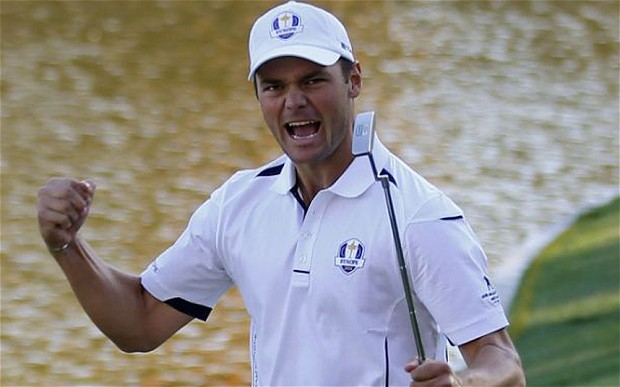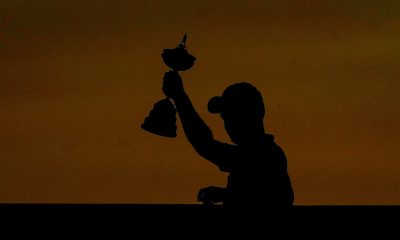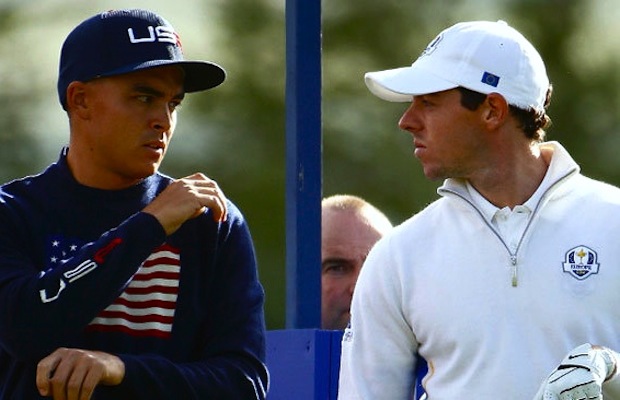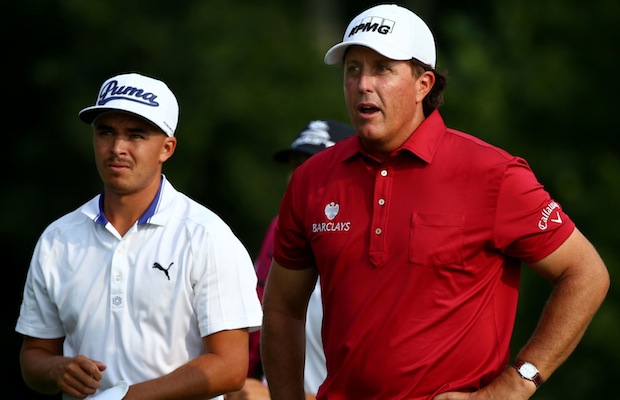Opinion & Analysis
Wunder: The Ryder Cup Awards

What good is a team competition if you can’t identify the individuals who provided the greatest contributions to the cause?
I was very proud to be a golf fan this weekend and I am confident that the game is in better shape than it was a week ago. The festivities at Medinah were like taking in the Star Wars trilogy over a long weekend. There were heroes, villains, ups, downs, comedy, drama and so much else to satisfy our pallets. It was epic.
Sure the U.S. Team lost but we have not fielded a “team” like we did in 2012 in more than a decade. What I mean is although I’m certain the team unity has been there in past years, it was never as visible as it was at Medinah. We had a ball club out there this weekend — each man was fulfilling a duty in the best way he knew how. In the end, the score (which should have ended in a tie, but that’s another story) concluded with yet another European victory. But this time, I, as an American golf fan, was not left scratching my head wondering why. It was a three-day competition where a great horse came from the middle of the pack to beat another great horse. It’s actually very liberating to not have to point the finger at someone. All I have are accolades to give.
So without further ado, here are the winners:
TEAM EUROPE
Rookie of the week: Nicolas Colsaerts
A complete and utter no brainer. Not only was he the only rookie on the European side, he announced his Ryder Cup debut on Friday afternoon with seven birdies and an eagle against Tiger and Stricker. He seemed completely unphased by the pressure. He did, however, finish the week 1-3, but a year from now we won’t remember anything but his performance on Friday.
Comeback player: Sergio Garcia
The Spaniard lost his first two matches of the week. But from Saturday afternoon foursomes to the his singles victory over Jim Furyk, Sergio pulled out the two wins that in my opinion broke the Americans back. Like his mentor Seve Ballesteros, Garcia won without his best stuff just by treating each hole as its own unique match. It was inspiring to watch and further strengthened my feeling that Sergio is always an asset in these matches. He possesses that Ryder Cup X-Factor that our top American veterans don’t have.
MVP: Martin Kaymer
I’ll probably take a beating for this one for not acknowledging Ian Poulter, but let me say this — Kaymer made the second most pressure-packed putt in Ryder Cup history. He not only redeemed his countryman Bernhard Langer — he redeemed himself. Despite the many questions about the state his game, he put his head down and drilled a putt to win the Ryder Cup. Nothing he will ever do personally in the game will trump that. As the great Ty Webb said, “Don’t worry about this one, you miss it, we lose.” Enough said.
Honorable Mention: Jose Marie Olazabal
If you study the footage and watch Olie throughout these matches, his reaction was stoic. He was a brick wall and that energy, even in times of defeat, gives players a sense of security. He never looked panicked or even really affected by what was happening. Like a great field general he waited until the final outcome was revealed to express his emotion. It was brilliant. To have that confidence when you aren’t the one hitting the shots is impressive. If the outcome was different he would have taken a beating in the press, unfairly in my opinion.
TEAM USA
Rookie of the week: Keegan Bradley
Let’s identify what really happened for U.S. Golf this week — an American became a Ryder Cup team leader. With the smiles, fist pumps, bear hugs, passion and everything else, Keegan Bradley represented exactly what we want to see from our U.S. players. Granted, he lost on Sunday and squandered opportunities to become a golf immortal, but the fireworks he provided were awe inspiring. For the first time in a while, an American Ryder Cup player matched the energy of the crowd. Bradley allowed me to forget about the overall loss and appreciate the fact that we have an American that will energize us for years to come.
Comeback player: Phil Mickelson (via Keegan Bradley)
Phil was golf fan No. 1 this week. His play was up and down, but his enthusiasm and mentorship of Bradley was more than we could ask for. He took full advantage of his time with Bradley and rode the young stallion to a 3-0 team record. I agree he probably could have played on Saturday afternoon but his intentions were in the spirit of what was best for the team, a quality that gets looked over quite a bit with him. Phil has taken responsibility for the fact that his legacy on Tour is far more than victories in majors, it’s his ability to pass on his wisdom and enthusiasm to the younger guys that will carry it on. These young stars look to him to lead and he delivers. As a fan I thank him for that. It’s far more important to me than his record in these matches.
MVP: Dustin Johnson
DJ redeemed himself this week. After going 1-3 in Wales, he came back strong with a 3-0 record and holed a putt at the 17th hole on Saturday that at the time seemed to have the U.S. team on its way to victory. Although DJ isn’t the most emotional player, it was nice to see his reaction on No. 17. He had struggled all day and that putt forgave all previous sins. On Sunday his five-birdie victory over Nicolas Colsaerts provided the last bit of comfort U.S. fans would experience.
…
We kind of all won this week. It seemed like the Cup this year was three matches in one. Like great cinema we were privileged to watch great golf played with heart and a love of country. I hope this fire continues and I can’t wait until I get those goosebumps again. Like a pure golf shot off the center of the face, it’s those that keep us coming back for more.
Thanks boys. See you at Gleneagles in 2014.
Opinion & Analysis
The 2 primary challenges golf equipment companies face

As the editor-in-chief of this website and an observer of the GolfWRX forums and other online golf equipment discourse for over a decade, I’m pretty well attuned to the grunts and grumbles of a significant portion of the golf equipment purchasing spectrum. And before you accuse me of lording above all in some digital ivory tower, I’d like to offer that I worked at golf courses (public and private) for years prior to picking up my pen, so I’m well-versed in the non-degenerate golf equipment consumers out there. I touched (green)grass (retail)!
Complaints about the ills of and related to the OEMs usually follow some version of: Product cycles are too short for real innovation, tour equipment isn’t the same as retail (which is largely not true, by the way), too much is invested in marketing and not enough in R&D, top staffer X hasn’t even put the new driver in play, so it’s obviously not superior to the previous generation, prices are too high, and on and on.
Without digging into the merits of any of these claims, which I believe are mostly red herrings, I’d like to bring into view of our rangefinder what I believe to be the two primary difficulties golf equipment companies face.
One: As Terry Koehler, back when he was the CEO of Ben Hogan, told me at the time of the Ft Worth irons launch, if you can’t regularly hit the golf ball in a coin-sized area in the middle of the face, there’s not a ton that iron technology can do for you. Now, this is less true now with respect to irons than when he said it, and is less and less true by degrees as the clubs get larger (utilities, fairways, hybrids, drivers), but there remains a great deal of golf equipment truth in that statement. Think about it — which is to say, in TL;DR fashion, get lessons from a qualified instructor who will teach you about the fundamentals of repeatable impact and how the golf swing works, not just offer band-aid fixes. If you can’t repeatably deliver the golf club to the golf ball in something resembling the manner it was designed for, how can you expect to be getting the most out of the club — put another way, the maximum value from your investment?
Similarly, game improvement equipment can only improve your game if you game it. In other words, get fit for the clubs you ought to be playing rather than filling the bag with the ones you wish you could hit or used to be able to hit. Of course, don’t do this if you don’t care about performance and just want to hit a forged blade while playing off an 18 handicap. That’s absolutely fine. There were plenty of members in clubs back in the day playing Hogan Apex or Mizuno MP-32 irons who had no business doing so from a ballstriking standpoint, but they enjoyed their look, feel, and complementary qualities to their Gatsby hats and cashmere sweaters. Do what brings you a measure of joy in this maddening game.
Now, the second issue. This is not a plea for non-conforming equipment; rather, it is a statement of fact. USGA/R&A limits on every facet of golf equipment are detrimental to golf equipment manufacturers. Sure, you know this, but do you think about it as it applies to almost every element of equipment? A 500cc driver would be inherently more forgiving than a 460cc, as one with a COR measurement in excess of 0.83. 50-inch shafts. Box grooves. And on and on.
Would fewer regulations be objectively bad for the game? Would this erode its soul? Fortunately, that’s beside the point of this exercise, which is merely to point out the facts. The fact, in this case, is that equipment restrictions and regulations are the slaughterbench of an abundance of innovation in the golf equipment space. Is this for the best? Well, now I’ve asked the question twice and might as well give a partial response, I guess my answer to that would be, “It depends on what type of golf you’re playing and who you’re playing it with.”
For my part, I don’t mind embarrassing myself with vintage blades and persimmons chasing after the quasi-spiritual elevation of a well-struck shot, but that’s just me. Plenty of folks don’t give a damn if their grooves are conforming. Plenty of folks think the folks in Liberty Corner ought to add a prison to the museum for such offences. And those are just a few of the considerations for the amateur game — which doesn’t get inside the gallery ropes of the pro game…
Different strokes in the game of golf, in my humble opinion.
Anyway, I believe equipment company engineers are genuinely trying to build better equipment year over year. The marketing departments are trying to find ways to make this equipment appeal to the broadest segment of the golf market possible. All of this against (1) the backdrop of — at least for now — firm product cycles. And golfers who, with their ~15 average handicap (men), for the most part, are not striping the golf ball like Tiger in his prime and seem to have less and less time year over year to practice and improve. (2) Regulations that massively restrict what they’re able to do…
That’s the landscape as I see it and the real headwinds for golf equipment companies. No doubt, there’s more I haven’t considered, but I think the previous is a better — and better faith — point of departure when formulating any serious commentary on the golf equipment world than some of the more cynical and conspiratorial takes I hear.
Agree? Disagree? Think I’m worthy of an Adam Hadwin-esque security guard tackle? Let me know in the comments.
@golfoncbs The infamous Adam Hadwin tackle ? #golf #fyp #canada #pgatour #adamhadwin ? Ghibli-style nostalgic waltz – MaSssuguMusic
Podcasts
Fore Love of Golf: Introducing a new club concept

Episode #16 brings us Cliff McKinney. Cliff is the founder of Old Charlie Golf Club, a new club, and concept, to be built in the Florida panhandle. The model is quite interesting and aims to make great, private golf more affordable. We hope you enjoy the show!
Opinion & Analysis
On Scottie Scheffler wondering ‘What’s the point of winning?’

Last week, I came across a reel from BBC Sport on Instagram featuring Scottie Scheffler speaking to the media ahead of The Open at Royal Portrush. In it, he shared that he often wonders what the point is of wanting to win tournaments so badly — especially when he knows, deep down, that it doesn’t lead to a truly fulfilling life.
View this post on Instagram
“Is it great to be able to win tournaments and to accomplish the things I have in the game of golf? Yeah, it brings tears to my eyes just to think about it because I’ve literally worked my entire life to be good at this sport,” Scheffler said. “To have that kind of sense of accomplishment, I think, is a pretty cool feeling. To get to live out your dreams is very special, but at the end of the day, I’m not out here to inspire the next generation of golfers. I’m not out here to inspire someone to be the best player in the world, because what’s the point?”
Ironically — or perhaps perfectly — he went on to win the claret jug.
That question — what’s the point of winning? — cuts straight to the heart of the human journey.
As someone who’s spent over two decades in the trenches of professional golf, and in deep study of the mental, emotional, and spiritual dimensions of the game, I see Scottie’s inner conflict as a sign of soul evolution in motion.
I came to golf late. I wasn’t a junior standout or college All-American. At 27, I left a steady corporate job to see if I could be on the PGA Tour starting as a 14-handicap, average-length hitter. Over the years, my journey has been defined less by trophies and more by the relentless effort to navigate the deeply inequitable and gated system of professional golf — an effort that ultimately turned inward and helped me evolve as both a golfer and a person.
One perspective that helped me make sense of this inner dissonance around competition and our culture’s tendency to overvalue winning is the idea of soul evolution.
The University of Virginia’s Division of Perceptual Studies has done extensive research on reincarnation, and Netflix’s Surviving Death (Episode 6) explores the topic, too. Whether you take it literally or metaphorically, the idea that we’re on a long arc of growth — from beginner to sage elder — offers a profound perspective.
If you accept the premise literally, then terms like “young soul” and “old soul” start to hold meaning. However, even if we set the word “soul” aside, it’s easy to see that different levels of life experience produce different worldviews.
Newer souls — or people in earlier stages of their development — may be curious and kind but still lack discernment or depth. There is a naivety, and they don’t yet question as deeply, tending to see things in black and white, partly because certainty feels safer than confronting the unknown.
As we gain more experience, we begin to experiment. We test limits. We chase extreme external goals — sometimes at the expense of health, relationships, or inner peace — still operating from hunger, ambition, and the fragility of the ego.
It’s a necessary stage, but often a turbulent and unfulfilling one.
David Duval fell off the map after reaching World No. 1. Bubba Watson had his own “Is this it?” moment with his caddie, Ted Scott, after winning the Masters.
In Aaron Rodgers: Enigma, reflecting on his 2011 Super Bowl win, Rodgers said:
“Now I’ve accomplished the only thing that I really, really wanted to do in my life. Now what? I was like, ‘Did I aim at the wrong thing? Did I spend too much time thinking about stuff that ultimately doesn’t give you true happiness?’”
Jim Carrey once said, “I think everybody should get rich and famous and do everything they ever dreamed of so they can see that it’s not the answer.”
Eventually, though, something shifts.
We begin to see in shades of gray. Winning, dominating, accumulating—these pursuits lose their shine. The rewards feel more fleeting. Living in a constant state of fight-or-flight makes us feel alive, yes, but not happy and joyful.
Compassion begins to replace ambition. Love, presence, and gratitude become more fulfilling than status, profits, or trophies. We crave balance over burnout. Collaboration over competition. Meaning over metrics.
Interestingly, if we zoom out, we can apply this same model to nations and cultures. Countries, like people, have a collective “soul stage” made up of the individuals within them.
Take the United States, for example. I’d place it as a mid-level soul: highly competitive and deeply driven, but still learning emotional maturity. Still uncomfortable with nuance. Still believing that more is always better. Despite its global wins, the U.S. currently ranks just 23rd in happiness (as of 2025). You might liken it to a gifted teenager—bold, eager, and ambitious, but angsty and still figuring out how to live well and in balance. As much as a parent wants to protect their child, sometimes the child has to make their own mistakes to truly grow.
So when Scottie Scheffler wonders what the point of winning is, I don’t see someone losing strength.
I see someone evolving.
He’s beginning to look beyond the leaderboard. Beyond metrics of success that carry a lower vibration. And yet, in a poetic twist, Scheffler did go on to win The Open. But that only reinforces the point: even at the pinnacle, the question remains. And if more of us in the golf and sports world — and in U.S. culture at large — started asking similar questions, we might discover that the more meaningful trophy isn’t about accumulating or beating others at all costs.
It’s about awakening and evolving to something more than winning could ever promise.



























